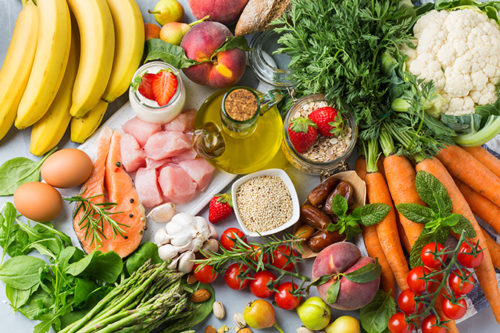“Don’t dig your grave with your own knife and fork” – English proverb
Fat, salt and sugar are each needed in our diets, but too much of these can lead to chronic illnesses that impact our quality of life. It’s important to eat foods that are full of nutrients, while reducing added fat, salt and sugar.
 Fat
Fat Experts say that adults should consume 44-77 grams of fat each day, but too much unhealthy fat in a diet can lead to weight gain and higher risk for chronic diseases such as obesity, heart disease and diabetes.
There are many ways to reduce unhealthy fats and increase healthy fats in your diet:
- When a restaurant serves you a large portion, split it with a friend or save half of it for leftovers.
- Instead of shortening, butter or margarine, cook with healthier fats such as olive, canola or corn oil.
- Replace higher fat foods from animal sources with fruits, vegetables, beans and nuts.
- Choose tomato-based sauces instead of those that are cheese or cream-based.
- Choose a fruit salad, low-fat ice cream or frozen yogurt, instead of a high-fat, high-sugar dessert.
- Bake, broil, grill or microwave foods rather than fry them.
- Choose lean meats, fish, chicken and turkey.
- Drink skim or 1% low-fat milk.
- When you eat a higher-fat food, eat a smaller serving of it.
Salt
Salt contains sodium, an ingredient your body needs to regulate fluids and manage your blood pressure, among other benefits; however, too much sodium can cause high blood pressure in kids and adults. Your body needs only 500 milligrams (1/4 teaspoon) of sodium a day to function well, but up to 1,500- 2,300 mg (about one teaspoon) is still considered a healthy daily amount. This includes all the sodium you eat: what is naturally in foods; the salt added to foods by food manufacturers; the salt that is added to foods during cooking; and the salt you add just before eating them. The average American consumes 3,400 mg or more, (almost 2 teaspoons or more) each day, well over the recommended amount, which could lead to high blood pressure, stroke, heart failure and kidney disease.
There are several strategies for reducing sodium in your diet:
- Check food labels and choose items low in sodium (140 mg or less per serving).
- Enjoy home-prepared foods where the amount of salt can be controlled.
- Do not add table salt to foods – try keeping the salt shaker off the table.
- Instead of using salt to flavor food, try herbs like garlic, onion powder, pepper, or lemon and lime juices or different types of vinegar.
- Eat more whole foods, such as fruits and vegetables, which are naturally low in sodium compared with processed foods.
- Rinse canned vegetables before preparing food.
Sugar
The average American consumes about 20 tsp of sugar each day – double the maximum recommendation. When sugar is consumed in high amounts, it can cause health problems like cavities, weight gain, diabetes and heart disease. Added sugars are different from natural sugars. Natural sugars are found in foods like milk, fruits and 100% fruit juices. Natural sugars often provide nutrients while also providing sugar. Added sugar provides no nutrients.
To reduce added sugars in your diet, you can:
- Add fruit to your foods when baking, like raisins or applesauce.
- Drink water instead of soda, energy or sports drinks.
- Drink skim (non-fat) or 1% milk rather than full-fat milk.
- Sweeten your foods with fruit.
- Choose freshly prepared foods and treats instead of processed foods.
- Eat foods and drink beverages with few added sugars.
- Dilute fruit juice with water.
- Add spices, such as cinnamon, to sweeten foods.
- Rinse canned fruits that have light or heavy syrup.







Leave A Comment
You must be logged in to post a comment.